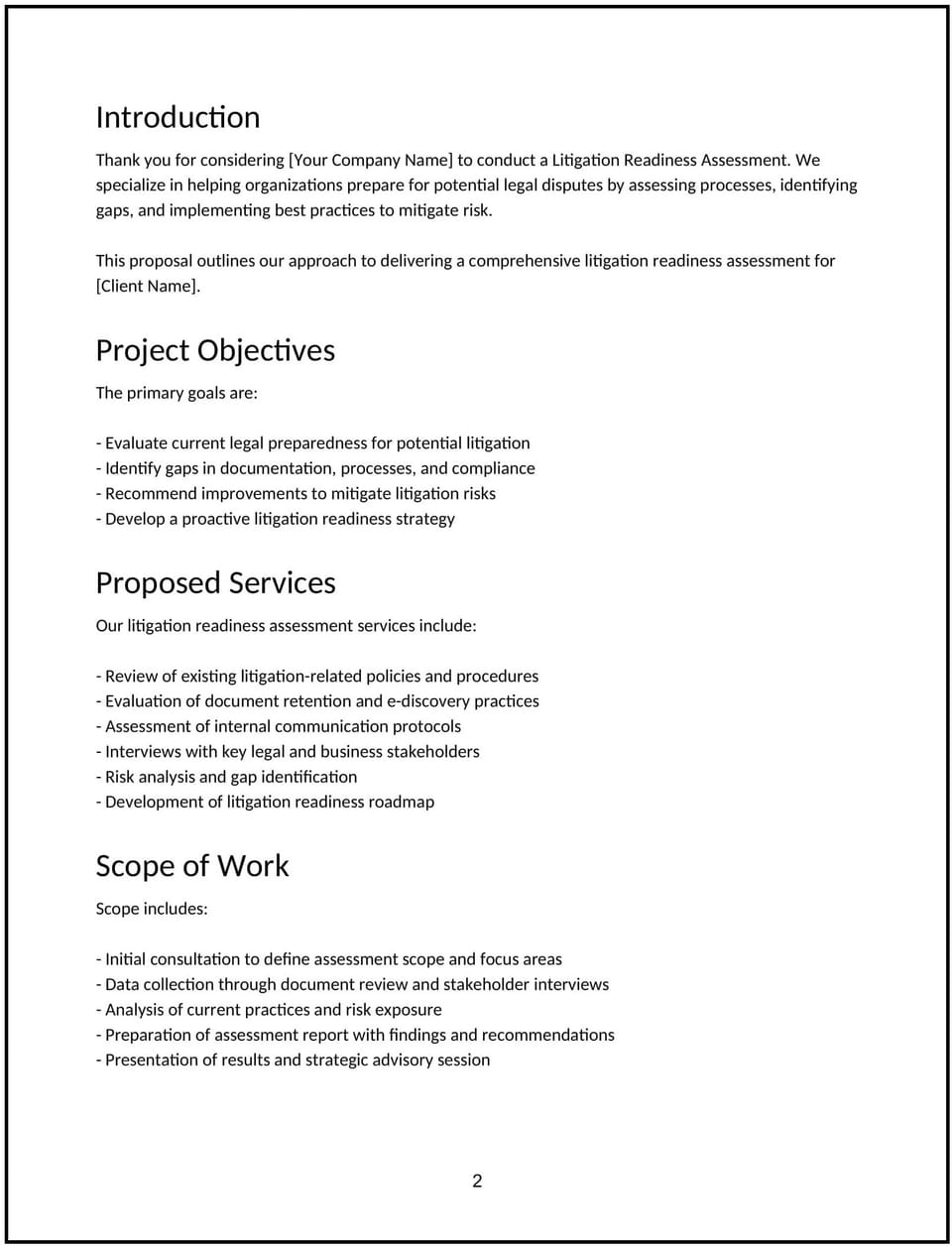Litigation readiness assessment proposal: Free template

Customize this free litigation readiness assessment proposal with Cobrief
Open this free litigation readiness assessment proposal in Cobrief and start editing it instantly using AI. You can adjust the tone, structure, and content based on your client’s industry, exposure, and internal processes. You can also use AI to review your draft — identify vague steps, flag missing components, and improve clarity before sending.
Once you're done, send, download, or save the proposal in one click — no formatting or setup required.
This template is fully customizable and built for real-world use — ideal for legal teams, compliance officers, or operations leaders looking to assess litigation risk, document preservation protocols, and internal response readiness. Whether you’re conducting a standalone review or embedding this in a broader risk audit, this proposal helps you scope, explain, and close work faster.
What is a litigation readiness assessment proposal?
A litigation readiness assessment proposal outlines how you’ll evaluate a business’s ability to respond efficiently and defensibly to potential legal claims. It includes your methodology, scope of review, deliverables, and pricing — and is typically shared before conducting internal interviews or reviewing workflows.
This proposal is commonly used by law firms, legal ops teams, and risk consultants working with businesses that face regulatory scrutiny, contractual disputes, or potential employee claims. It helps identify where legal exposure could be worsened by poor data handling, unclear roles, or lack of documentation.
Unlike a general legal health check, this proposal focuses specifically on legal process preparedness — such as hold procedures, evidence tracking, and legal team workflows.
Why use Cobrief to edit your proposal
- Edit the full proposal instantly: No document formatting or setup required — just open and edit in-browser.
- Use AI to tailor scope and tone: Adjust based on industry, size, or known litigation exposure.
- Run a full AI-powered review: Catch vague timelines, unclear deliverables, or missing procedural steps.
- Apply edits in one click: Accept suggestions manually or apply all updates at once.
- Save, send, or download: Export your finished proposal in seconds, ready to share.
When to use this proposal
- When a client wants to assess their legal exposure or internal preparedness before a dispute arises
- When responding to a company undergoing structural change, growth, or increased legal scrutiny
- When bundling this assessment with risk audits, policy development, or eDiscovery setup
- When helping a GC or in-house legal team build defensible legal workflows
- When preparing for regulatory inspections or audit readiness across departments
What to include in a litigation readiness assessment proposal
- Project overview: Summarize the goal of the review — such as reducing legal exposure, improving evidence handling, or identifying workflow gaps. Tailor this to the client’s industry and litigation risks.
- Scope of work: List the specific areas you'll assess — e.g., document retention, legal hold procedures, communication protocols, incident response, third-party risk, and litigation history. Clarify what’s in-scope (and what’s not).
- Timeline: Provide a clear timeline from kickoff to final report — including stakeholder interviews, data requests, process mapping, and findings presentation.
- Deliverables: Specify what the client will receive — typically an assessment report, risk map, prioritized recommendations, and optional implementation plan.
- Pricing: Present your pricing clearly — as a flat fee, per-entity rate, or hourly consulting model. Note if follow-on work (like remediation or ongoing support) is included or billed separately.
- Call to action / next steps: End with a clear prompt — approve the proposal, provide initial access, or schedule a kickoff call. Make the path forward simple and direct.
How to write an effective litigation readiness assessment proposal
- Frame the business risk: Emphasize that litigation readiness reduces cost, reputational damage, and internal disruption.
- Speak across functions: Use language that appeals to legal, ops, and executive teams — not just lawyers.
- Be transparent about scope: Define what will and won’t be reviewed — especially for multinational or complex orgs.
- Show strategic value: Highlight how improved readiness supports broader risk and compliance goals.
- Keep the tone clear and consultative: Clients want clarity, not legalese.
- Close with action: Always include a confident next step that drives momentum.
Frequently asked questions (FAQs)
What areas does a litigation readiness assessment cover?
It typically includes legal hold protocols, document retention policies, communication review, role clarity, escalation paths, and litigation history analysis. You can tailor scope by industry and risk level.
Is this proposal only for large companies?
No — any business that could face legal claims can benefit. This proposal works for startups, mid-size companies, and enterprise clients alike.
Can I include follow-up implementation or training?
Yes — you can offer post-assessment support, such as updating policies, running mock exercises, or delivering legal team training.
Does this include reviewing contracts or employment policies?
It can, if relevant. Just clarify in the scope whether you’re assessing contractual exposure or limiting the review to litigation workflows.
Is this proposal a legal engagement?
No — this outlines your services and pricing. A formal engagement letter or contract should follow upon approval.
This article contains general legal information and does not contain legal advice. Cobrief is not a law firm or a substitute for an attorney or law firm. The law is complex and changes often. For legal advice, please ask a lawyer.